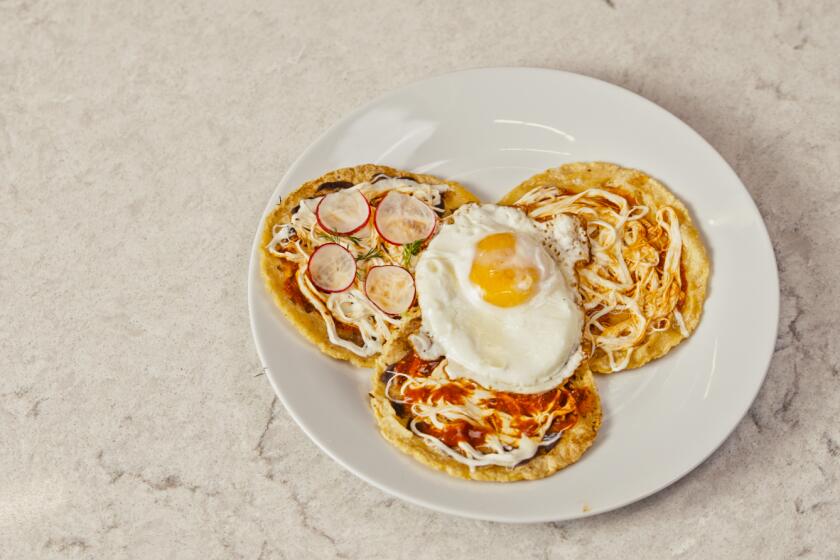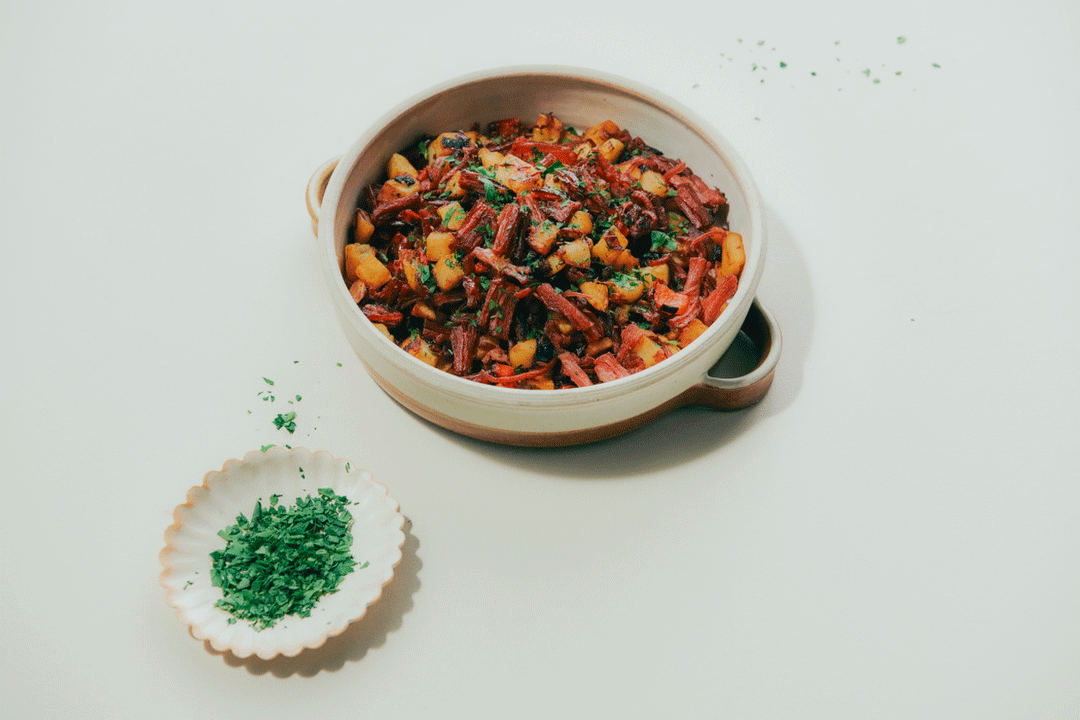Scrambled Eggs in Salsa Verde With Caviar

- Share via
Ferias, the country fairs of Mexico and Spain, are times of passion, joy and wonder. During the short days that the feria lasts, we let our feelings run at high speed. It’s as Jean Paul Sartre once wrote on another subject: “It is a moment when the real world gives way to a world of magic.”
For many years, my husband and I traveled the roads of Mexico and Spain, going from feria to feria, following our favorite bullfighters: the Mexican Manolo Martinez and the Spaniard Paco Camino, who were disputing which was the best bullfighter on Earth. They were both magic!
But the magic extended beyond the bullring. We found it also in the food we ate, in the music we heard and with the many friends we made in each of the towns where the ferias were held.
Of all the ferias in Mexico, my favorite is the feria of San Marcos, Aguascalientes, in central Mexico. I still have very fond memories of one particular feria there in 1977. That was when my mother and her friends first became known as Las Coyotas (the coyote girls).
That year, a group of her friends decided to join us for the feria, forming a very unorthodox bullfight mob. We stayed at the Francia Hotel, which, back then, was the place where everyone connected with the feria stayed, including the bullfighters.
The breakfast at the Francia was absolutely spectacular. There were chilaquiles and eggs served in a wonderful variety of ways: eggs with cactus and cilantro or in salsa verde, eggs rancheros (fried eggs on top of tortillas covered with spicy tomato sauce), a la mexicana (scrambled eggs with chopped serrano chile, onion and tomato--the colors of the Mexican flag) or motulenos (fried eggs on top of tortillas with beans, chopped ham, peas, tomato sauce and cheese). Then there were the Mexican biscochos (sweet breads) and chocolate.
You could also choose from a variety of Aguascalientes specialties, such as enchiladas rojas and condoches, also called gorditas de horno. These last are small puffy tortillas that can be sweet or salty, depending on the ingredient you use--jocoqui (yogurt) or coconut oil--or filled with beans and chile. There was also pork loin with guava sauce, chocolate tamales and, above all, the most delicious birria.
In the central region of Mexico, in the states of Jalisco, Guanajuato, Aguascalientes and Zacatecas, birria is the greatest dish, made from goat or lamb that has been seasoned with spices and chiles and cooked in a pit barbecue. The people of the region will tell you that birria is the right choice for breakfast after a long day and night of tequilas and cubas (or cuba libres--rum and cola).
After breakfast, the women would walk to the fairgrounds to buy arts and crafts while the men would gather at the bullring to witness the drawing of the bulls, a little ceremony during which the manager of each bullfighter finds out which bulls his man will fight.
At lunch we would meet at any of the small restaurants surrounding the bullring, where they have an amazing variety of Mexican dishes and antojitos, which are finger foods or munchies that can be truly extraordinary. For example: tacos al pastor, quesadillas, gorditas, panuchos and sopes. And, of course, in each restaurant, bands of mariachis were always playing.
Once we were in the bullring, the band would play those magnificent pasodobles until the cornet announced that the fight would begin. There were moments of intense suffering during the fight that were compensated for with moments of immense joy. It was magic!
When the bullfight was over, we would all go back to the hotel to rest. Later, there were always parties to go to, gambling in improvised casinos on the fairgrounds, shows with some of the best Mexican singers, or just strolling on the square of San Marcos with a tambora (band of musicians) following closely behind you.
I remember on one of those nights that Manolo Martinez invited us to his friend’s place to play poker. Manolo was a good poker player, and he really liked to win. That night, he must have thought he could win big playing against my mother and her friends. Little did he know that these ladies were very experienced players.
As soon as he began to lose, he positioned the members of his cuadrilla team behind each of the ladies and right before placing a bet he would wait for a signal from each of them.
My mother’s friends were no innocents and immediately began playing their cards really close to their vests, making it impossible for the guys to know what they had. Feeling desperate after a few lost hands, Manolo called for my husband, who was in another room, and demanded an explanation about these ladies who were taking him to the cleaners.
That night they were baptized Las Coyotas, because he just couldn’t believe they could be smarter and better than him at a game he had been playing for so long.
That name has stuck with them until today, though Manolo is gone. He died young, but he sure lived life at its fullest. For him, every day was magic, a feria.
Salsa Verde
Place tomatillos, chiles and garlic in baking dish and roast at 425 degrees until tender, about 30 minutes.
Puree roasted tomatillos, chiles and garlic in blender or food processor with onion, cilantro and salt. Makes 2 cups.
Assembly
Heat oil in large skillet over medium-high heat. Pour in Salsa Verde and bring to boil.
Beat eggs in bowl and add to skillet. Cook over medium heat until eggs are softly scrambled, about 5 minutes.
Divide among 4 dishes and spoon caviar on top center of scrambled eggs. Season with salt to taste. Serve with corn or flour tortillas.
Get our Cooking newsletter.
Your roundup of inspiring recipes and kitchen tricks.
You may occasionally receive promotional content from the Los Angeles Times.















